
 |
Thirtieth
Division
(Official History)
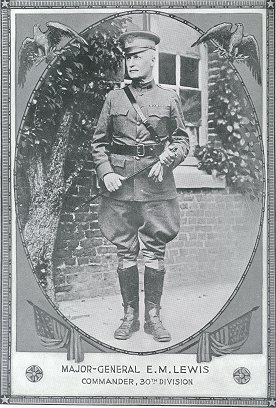 The
Thirtieth Division was a distinctively American division. More than
95 per cent of its personnel was of American-born parents. The division
was constituted of National Guard troops of North Carolina, South Carolina,
and Tennessee, augmented by many thousands of selective draft troops from
the states of Indiana, Illinois, Iowa, Minnesota, North Dakota, North
Carolina, South Carolina and Tennessee.
The
Thirtieth Division was a distinctively American division. More than
95 per cent of its personnel was of American-born parents. The division
was constituted of National Guard troops of North Carolina, South Carolina,
and Tennessee, augmented by many thousands of selective draft troops from
the states of Indiana, Illinois, Iowa, Minnesota, North Dakota, North
Carolina, South Carolina and Tennessee.
The division was dubbed "Old Hickory" after the warrior and statesman, Andrew Jackson, who was so closely identified with the history of the states furnishing the major portion of its personnel.
The Old Hickory Division landed at the port of Calais, France, on the 24th day of May, 1918, and was billeted in the Eperlocques Training Area. While in this area the officers of the division reconnoitered the Terdeghen Switch Line, south of Cassel, and complete plans were formulated for the occupation of this line by forced marches in case of emergency.
Before the completion of its training period, the division was transferred to the II British Corps, Second Army, in the Ypres sector to be in close support in case of the expected German offensive. This division, the first American division to enter that kingdom, marched into Belgium on July 4th, with Division Headquarters at Watou, to be in close support of the 33rd and 49th British Divisions, and was employed in completing the construction of the East and West Poperinghe Defense Systems immediately in rear of these two divisions. All immense amount of trench and wire construction was done. Complete plans and orders were issued for the occupation of the East and West Poperinghe Systems by the 30th Division in the event of a German attack and a forced withdrawal of the British Divisions in the front. The division received training in the front line with the 33rd and 49th Divisions, first as individuals, then by platoons, and lastly by entire battalions.
On August 17, 1918, the division took over the entire sector occupied by the 33rd British Division, 60th Brigade being in the front line, 59th Brigade in support. This was known as the Canal Sector and extended from the southern outskirts of Ypres to the vicinity of Voormezeele, a distance of 2,400 metres.
 |
| Click map to view enlargement. |
On August 31 and September 1 the division engaged in an offensive in conjunction with the 14th British Division on the left and 27th American Division on the right. The 30th Division captured all its objectives, including Lock No. 8, Lankhof Farm, and the City of Voormezeele, advancing fifteen hundred yards, capturing fifteen prisoners, two machine-guns and thirty-five rifles. As a result of this advance the 236th Division, which was considered an average German division, was identified. During the six weeks previous to this advance, many attempts had been made by the British and our own troops to identify this German division.
On September 4-5, the division was withdrawn from the Canal Sector and placed in British G. H. Q. reserve with Division Headquarters at Roellecourt, France. While in this area the entire division was trained in attacking in conjunction with British tanks. On September 17, the division was again moved farther south with Division Headquarters at Herissart, and on September 22 was moved to the British Fourth Army with Division Headquarters at Bois de Buire, near Tincourt, taking over a front line sector from the 1st Australian Division on the night of September 23-24.
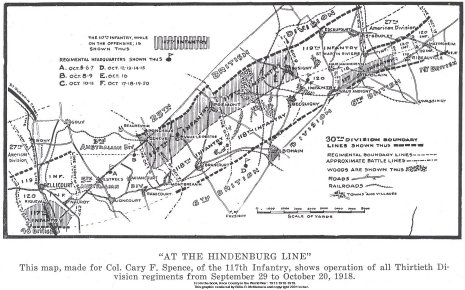 [Click
map at left to view enlargement.] September 29 this
division, with the 27th American Division on the left and the 46th British
Division on the right, assaulted the Hindenburg Line. The Hindenburg
Line at this point curved in front of the Tunnel of St. Quentin. This
was considered impregnable by the Germans for the following reasons: The
Hindenburg Line, curving west of the tunnel, consisted of three main trench
systems protected by vast fields of heavy barbed wire entanglements skillfully
placed. This wire was very heavy and had been damaged very little
by artillery fire. The dominating ground enabled them to bring devastating
machine-gun fire on all approaches. The lines had been strengthened
with concrete machine-gun emplacements. It contained at this point
a large number of dugouts, lined with mining timbers, with wooden steps
leading down to a depth of about 30 feet and with small rooms capable
of holding from four to six men each. In many cases, these dugouts
were wired for electric light. The large tunnel, through which the
canal ran, was of sufficient capacity to shelter a division. This
tunnel was electrically lighted and filled with barges. Connecting
it with the Hindenburg trench system were numerous tunnels. In one
case a direct tunnel ran from the main tunnel to the basement of a large
stone building, which the enemy used for headquarters. Other tunnels
ran from the main tunnel eastward to the City of Bellicourt and other
places. This complete subterranean system with its hidden exits
and entrances, unknown to us, formed a most complete and safe subterranean
method of communication and reinforcement for the German sector.
[Click
map at left to view enlargement.] September 29 this
division, with the 27th American Division on the left and the 46th British
Division on the right, assaulted the Hindenburg Line. The Hindenburg
Line at this point curved in front of the Tunnel of St. Quentin. This
was considered impregnable by the Germans for the following reasons: The
Hindenburg Line, curving west of the tunnel, consisted of three main trench
systems protected by vast fields of heavy barbed wire entanglements skillfully
placed. This wire was very heavy and had been damaged very little
by artillery fire. The dominating ground enabled them to bring devastating
machine-gun fire on all approaches. The lines had been strengthened
with concrete machine-gun emplacements. It contained at this point
a large number of dugouts, lined with mining timbers, with wooden steps
leading down to a depth of about 30 feet and with small rooms capable
of holding from four to six men each. In many cases, these dugouts
were wired for electric light. The large tunnel, through which the
canal ran, was of sufficient capacity to shelter a division. This
tunnel was electrically lighted and filled with barges. Connecting
it with the Hindenburg trench system were numerous tunnels. In one
case a direct tunnel ran from the main tunnel to the basement of a large
stone building, which the enemy used for headquarters. Other tunnels
ran from the main tunnel eastward to the City of Bellicourt and other
places. This complete subterranean system with its hidden exits
and entrances, unknown to us, formed a most complete and safe subterranean
method of communication and reinforcement for the German sector.
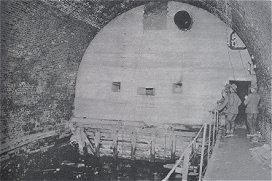 |
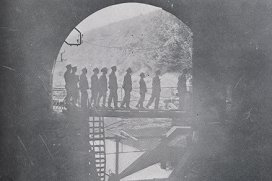 |
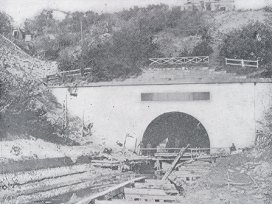 |
| The Hindenburg Tunnel Interior view, showing the way Germans had tunnel closed and the water of St. Quentin canal. |
Looking Out from the Tunnel South end, east of Bellicourt, where German barrage caught American troops. |
Mouth of Hindenburg Tunnel Looking north of St. Quentin Canal and showing defensive works built by the Germans. |
The Thirtieth Division, 60th Brigade, augmented by units of the 117th Infantry, attacking, assaulted this line at 5:50 a.m., September 29, on a front of three thousand yards, captured the entire Hindenburg System of that sector and advanced farther, capturing the tunnel system with the German troops therein; took the Cities of Bellicourt, Nauroy, Riqueval, Carriere, Etricourt, Guillaine Ferme and Ferme de Riqueval, advancing four thousand, two hundred yards, defeating two enemy divisions of average quality, (the 75th Reserve Division and the 185th Division), and taking as prisoners 47 officers and 1,434 men.
On October 1-2, the division was relieved by the 5th Australian Division and moved to a back area with division headquarters at Herbecourt. The division scarcely reached this area when it was marched back and took over the front line in the same sector from the 2nd Australian Division near Montbrehain on the night of October 4-5.
From October 8-11, the division attacked each day, advancing 17,500 yards, and capturing le Tilleul d'Archies, le Petit Cambresis, Becquigny, Mon. Sarasin, le Trou Aux Soldats, Busigny, Gloriette, le Vert Donjon, Escaufourt, le Rond Pont, Vaux-Andigny, Vallee Hasard, la Haie Menneresse, la Rochelle, le Vent de Bise, St. Souplet, St. Benin, Malassise, Geneve, half of Montbrehain, Brancourt, Premont, Vaux-le-Pretre, Brancoucourt, Fraicourt Ferme, Bois Mirand, Butry Ferme, la Sabliere Bois, Becquignette Ferme, Bois de Malmaison, Malmaison Ferme, Bois de Busigny, Bois l'Ermitage, Bois Proyart, Imberfayt and Du Guet Fassiaux Fermes, taking prisoners 45 officers and 1,889 men. The 59th Brigade began this attack on October 8 and captured all their objectives, including Premont and Brancourt. During this operation from October 8-11, the 30th Division encountered units from fourteen German divisions, classified by the British High Command as follows: 34th Division, average; 20th Division, very good; 24th Division, very good; 21st Division, average; 21st Reserve Division, average; 38th Division, very good; 119th Division, average; 121st Division, average; 187th Sharpshooting Section, very good; 204th Division, average; 208th Division, average; 3rd Naval Division, very good; 15th Reserve Division, average.
The 30th Division was relieved by the 27th Division on October 11-12, but returned on October 16 and took over a part of the same line at the same place, being the right half of the sector temporarily held by the 27th. The next attack was launched on October 17-19 against the 221st Division, average; 243rd Division, average; 29th Division, very good, advancing nine thousand yards and capturing 6 officers and 412 men, and the towns of Molain, St.-Martin Riviere, Ribeauville, Ecaillon, Mazinghein and Ribeaucourt Ferme.
During much of the fighting from October 8-11 and October 17-19, difficulties of the terrain were very great, with the country greatly broken by small patches of woods, while villages, with uneven terrain and occasional large towns, admirably added to the machine-gun defense of which the Germans took every advantage. The Selle River with high banks beyond was obstinately defended. In spite of these difficulties the advance continued, often without artillery support, and was made possible only by the determination of the men and the skillful use of all arms combined with clever utilization of the diversified terrain. The 3rd German Naval Division of the crack German divisions was hastily thrown in in an attempt to stop the advance.
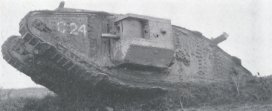 The
division was then withdrawn to the Heilly Training Area, near Amiens,
for replacements and a well-earned rest. Two weeks later, when orders
for an immediate return to the front were expected daily, the armistice
with Germany was signed November 11, 1918. The fighting being over,
the II American Corps was released from the British E. F., with which
it had been associated since its arrival in France, and transferred to
the American E. F. in the Le Mans area, where the first units of the 30th
Division arrived and Divisional Headquarters opened at Ballon on November
21. [Photo at right - "Heavy British Tank:
Moving ahead of infantry to find and destroy German machine gun
positions."]
The
division was then withdrawn to the Heilly Training Area, near Amiens,
for replacements and a well-earned rest. Two weeks later, when orders
for an immediate return to the front were expected daily, the armistice
with Germany was signed November 11, 1918. The fighting being over,
the II American Corps was released from the British E. F., with which
it had been associated since its arrival in France, and transferred to
the American E. F. in the Le Mans area, where the first units of the 30th
Division arrived and Divisional Headquarters opened at Ballon on November
21. [Photo at right - "Heavy British Tank:
Moving ahead of infantry to find and destroy German machine gun
positions."]
During the above operations the advance was so rapid and the troops withdrawn so soon, there was no opportunity to gather up and salvage a great number of guns and supplies captured, which were left for the salvage troops of the Fourth British Army. Upon a partial check by the units of the division, it is known that at least 72 field artillery pieces, 26 trench mortars, 426 machine guns and 1,792 rifles were captured in addition to the great mass of material. This represents but a portion of the captures. In many instances, field guns taken from the Germans were turned over to the supporting artillery and used by them upon the retreating enemy.
Total number of prisoners captured by this division from September 29 to October 20 were: 98 officers, 3,750 men. During the same period we lost 3 officers and 24 men as prisoners. The total casualties of the entire division, according to statistics of the War Department, were 1,652 killed and 9,429 wounded. The division stood eleventh in the army in the number of casualties.
The following messages and orders speak for themselves:
Australian Corps
Corps Headquarters,
2nd October, 1918.
To: Major-General G.
W. Read,
Comd'g., II American Corps.
My Dear General:
As the II American Corps has now been withdrawn from the line, and my official association with you and your troops has been, for the time being, suspended, I desire to express to you the great pleasure that it has been to me, and to the troops of the Australian Army Corps to have been so closely allied to you in the recent very important battle operations which have resulted in the breaking through of the main Hindenburg Line on the front of the Fourth British Army.
Now that fuller details of the work done by the 27th and 30th American Divisions have become available, the splendid gallantry and devotion of the troops in these operations have won the admiration of their Australian comrades. The tasks set were formidable, but the American troops overcame all obstacles and contributed in a very high degree to the ultimate capture of the whole tunnel system.
I shall be glad if you will convey to your Division Commanders my appreciation of and thanks for the work done, and to accept my best wishes for every possible success in the future.
Yours very sincerely,
John Monash,
Commanding Australian Corps.
October 9th, 1918.
Major-General G. W. Read,
II American Corps.
On this first occasion on which the II American Corps has taken part in battle of its own, I desire to convey to you, General Read, and all members of your staff as well as to all other ranks of the Thirtieth Division, my hearty congratulations on your victory today. The gallantry of your infantry and the precision with which all staff arrangements have worked has filled me with admiration and it has given me pleasure to report your unqualified success to Field Marshal Sir Douglas Haig.
Henry Rawlinson,
General, Commanding Fourth British Army.
Major-General G. W.
Read,
October 12, 1918.
II American Corps.
The Commander-in-Chief desires
you to convey to the officers and soldiers of your Corps his appreciation
of the magnificent qualities which have enabled them, against powerful
resistance, to advance more than ten miles and to take more than six thousand
prisoners since September twenty-seven.
McAndrews.
October 20, 1918.
Major-General G. W. Read,
II American Corps.
I wish to express to you personally,
and to all the officers and men serving under you, my warm appreciation
of the very valuable and gallant services rendered by you throughout the
recent operations with the 4th British Army. Called up to attack
positions of great strength held by a determined enemy, all ranks of the
27th and 30th Divisions under your command displayed an energy, courage
and determination in attack which proved irresistible. It does not
need me to tell you that in the heavy fighting of the past three weeks
you have earned the lasting esteem and admiration of your British comrades-in-arms
whose success you have so nobly shared.
D. Haig,
Field Marshal.
October 22nd, 1918.
II American Corps.
Now that the American Corps has come out of the line for a well-earned period of rest and training, I desire to place on record my appreciation of the gallantry and the fine soldierly spirit they have displayed throughout the recent hard fighting.
The breaking of the great Hindenburg System of defense, coupled with the capture of Brancourt, Busigny and St. Souplet, and finally the forcing of the passages of the Selle river, constitute a series of victories of which each officer, N. C. O. and man has every reason to feel proud.
The Corps has been very well supported by the artillery of the Australian Corps, to whom I desire to offer my best thanks for their skill and endurance during the long months they have now been in action.
The efficiency with which the staff work of the Corps has been carried out on this their first experience as a fighting Corps in the line of battle has filled me with admiration, and I attribute it largely to the zeal and unity of purpose which has throughout animated the whole Corps.
The outstanding feature of their recent victories has been the surpassing gallantry and self-sacrifice of the regimental officers and men. I congratulate them on their prowess and offer them, one and all, my warmest thanks for the leading part they have taken in the recent operations.
It is possible now to give the Corps a period of rest, during which special attention should be paid to the training of the smaller units in minor tactics, such as the attack of strong points and machine gun nests. The experience they have had of actual combat will assist them to improve their fighting efficiency in this respect.
In thanking the Corps as a
whole for the great services they have rendered to the Allied cause, I
desire to wish all ranks the best good fortune in the future.
Rawlinson,
Commanding 4th British Army.
Busigny, October 27, 1918.
Commanding General, 30th Division:
Acting as a representative of the commune and in its name, consequently in the name, too, of a part of France, I take the liberty to come and express to our liberator and to the gallant troops under your command our feelings of deepest and eternal gratitude.
For those who have not been submitted, as we have, for four years, to the intolerable and abhorred German yoke, it is difficult to realize how great were the relief, the joy, the well-being, in a word the unexpressible happiness, we all felt when the first Allied troops made their way through our village, and this great event has been for us like the dawn of a resurrection.
I should be very thankful to you if you would convey to all your officers, N. C. O.'s and men under your command, our deep feelings of admiration and eternal gratitude.
Please, Sir, accept the expression of my highest consideration, and believe me,
Yours most devotedly,
The Mayor of Busigny,
E. Mairis.
November 15th, 1918.
Commanding General, 30th Division:
1. Referring to the telegram from the Commander-in-Chief of appreciation of the sacrifice and service of the troops of the American Expeditionary Force, I feel that it should be impressed upon the men of our command that they, and the organizations to which they belong, have played an exceptional part in bringing about the magnificent results which the Commander-in-chief has so warmly eulogized, and that every advantage should be taken of this expression of what has been done in the past and confidence as to the future by those in command to inspire their men with pride in the service they have had as soldiers in the Army of the United States, and to keep alive this "proud consciousness of a new Americanism born of sacrifice."
2. I would request that
you convey to your command my appreciation of the part they have taken
in our great victory, and my thanks for their heroic devotion to duty;
and that I share with them their sorrow for fallen comrades, and their
pride in the high achievements of the men of this Corps.
G. W. READ,
Major-General, Commanding II Corps.
November 16th, 1918.
Commanding General, II American Corps:
Now that the II American Corps is leaving the British zone, I wish once more to thank you and all officers, non-commissioned officers and men under your command, on behalf both of myself and all ranks of the British Armies, in France and Flanders, for the very gallant and efficient service you have rendered during the period of your operations with the Fourth British Army.
On the 29th of September, you took part with distinction in the great and critical attack which shattered the enemy's resistance in the Hindenburg Line and opened the road to final victory. The deeds of the 27th and 30th American Divisions who on that day took Bellicourt and Nauroy and so gallantly sustained the desperate struggle for Bony, will rank with the highest achievements of this war. They will always be remembered by the British Regiments that fought beside you.
Since that date, through three weeks of almost continuous fighting, you advanced from one success to another, overcoming all resistance, beating off numerous counter-attacks, and capturing several thousand prisoners and many guns. The names of Brancourt, Premont, Busigny, Vaux-Andigny, St.-Souplet and Mazingheim testify to the dash and energy of your attacks.
I rejoice at the success which has attended your efforts and I am proud to have had you under my command.
(Signed) D. Haig,
Field Marshal.
[ Return to Knox County Genealogy Military Page ]
[ Return to Knox County Genealogy Main Page ]
Except as noted, all HTML code and graphics in the URL path [http://www.knoxcotn.org/military/wwi/] were created by and copyrighted 2001-2003 to Billie R. McNamara. All rights reserved. Please direct all questions and comments to Ms. McNamara.This page was last updated January 2, 2004. Visitor